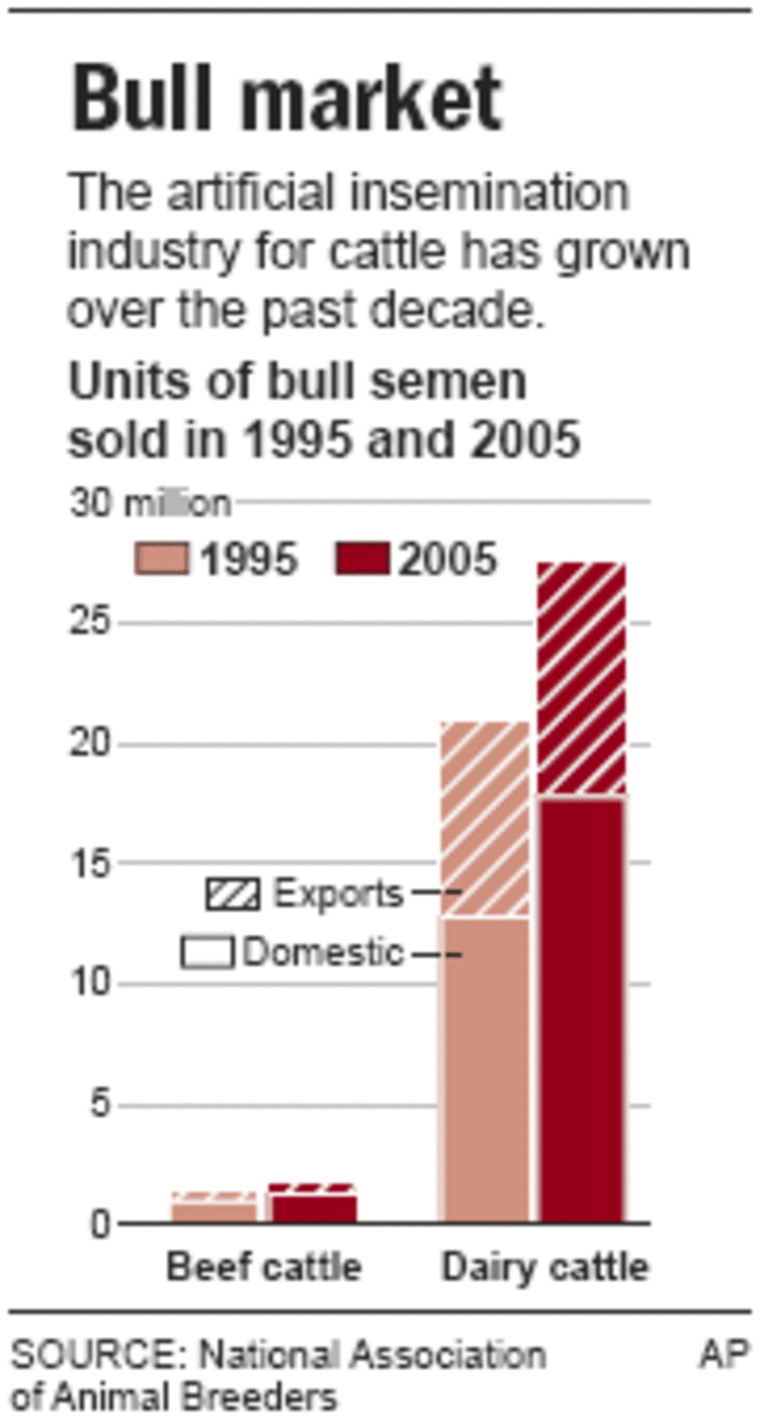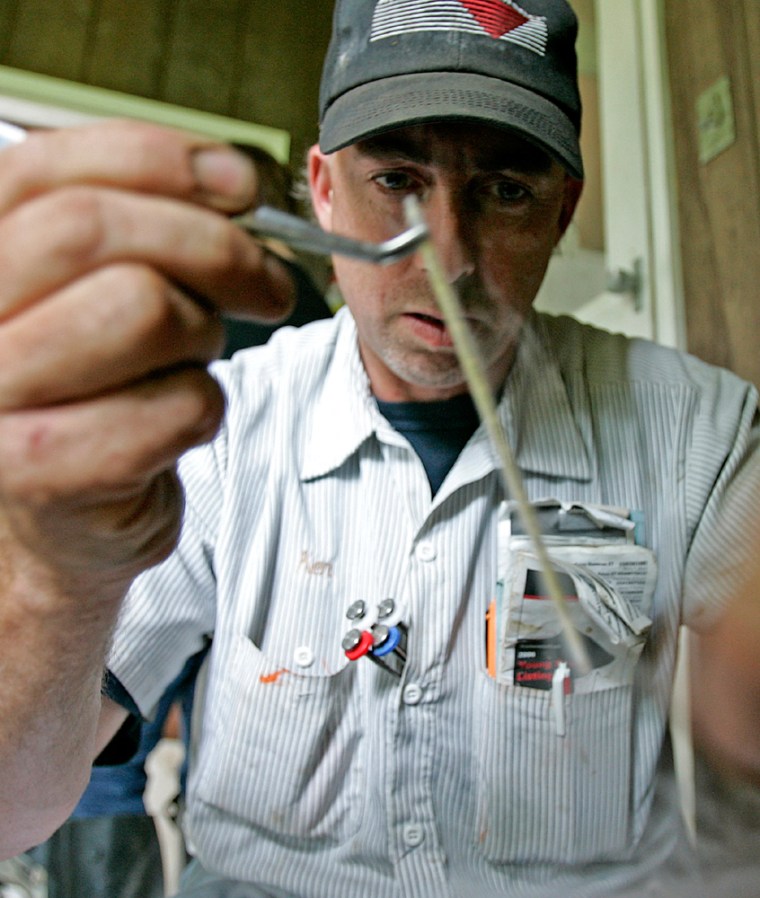Most of the 400 Holstein cows on B&B Dairy will never see a bull in their lives, but they are bred with some of the most sought-after studs in the world. The same went for their mothers and most of their grandmothers and great-grandmothers.
It's done through artificial insemination, a growing industry in the U.S. and abroad, which allows farmers to breed good traits like fertility and milk quality into their calves and breed out bad ones. Higher milk prices, heat-inducing drugs, better genes and the opening of more international markets are fueling the growth, according to National Association of Animal Breeders President Gordon Doak.
Matt Schultz, a herdsman at B&B, said the farm has used artificial insemination since 1987. The biggest advantage is not having a temperamental bull around that could kill someone, Schultz said.
"In a perfect world it would be pretty weird that these cows wouldn't see a bull, but in the dairy industry now, with the whole safety issue and everything like that, it's much better this way," said Schultz, 28.
The number of units of dairy bull semen sold within the nation has increased more than 39 percent and exports have risen nearly 20 percent from 1995 to 2005. For beef bull semen, domestic sales increased nearly 28 percent and exports rose nearly 15 percent.

Doak said U.S. farmers spent about $225 million last year on bull semen. Exports totaled about $56.4 million, although Doak said they are leveling off as foreign countries produce more bulls with good genetics.
Depending on the farmers' budget — a semen unit generally ranges in price from a couple dollars to $50 — they choose from bulls depending on the traits they produce. Those include fertility, milk production, butter fat production and protein content of milk.
About 95 percent of the dairy bull semen companies own or lease the bulls and collect the semen and market it, said Doak, whose 25-member association is based in Columbia, Mo. The others have bull owners bring the animals to the company's facility, where the semen is collected. The farmer either takes it home or the company stores it and ships it for the owner.
Just as the females' insemination works minus the male, the males' process is generally without a female.
The bulls are charmed with a teaser animal — usually a steer — and semen is collected with a radiator-like hose lined in latex so warm water can go between the hose and the lining.
"It's as natural as what would happen to him if he was just running out in a pasture with a cow," Doak said.
Semen frozen and stored
Once the semen is extracted, antibiotics and preservatives are added, and the mixture is frozen and stored, Doak said.
Paul VanRaden, a genetic researcher at the Animal Improvement Programs Laboratory of the U.S. Department of Agriculture, said an average dairy bull produces 10,000 daughters and 10,000 sons during his lifetime.
There are at least 10 bulls that have produced more than 1 million units of semen and several bulls that make more than $3 million a year, he said.
Having so many offspring increases the chances of inbreeding, but a computer registry keeps track of the cow and bull genetics, VanRaden said.
Evidence shows one of the first uses of artificial insemination dates to the Arabs in the 14th century, when tribes would steal sperm from rival tribes' horses, Doak said. The first official use was in Italian dogs in 1780.
Rutgers University in New Jersey formed the first commercial artificial insemination organization in the U.S. around 1938. Soon, there were about 100 organizations before consolidation left five companies that now do about 95 percent of the collecting and processing of semen, Doak said.
The nation's five biggest customers in 2005 were the United Kingdom, Japan, Mexico, Canada and Brazil according to the USDA.
Felipe Ruiz, general director for the Mexican Holstein Association in Queretaro, Mexico, said Mexican farmers use artificial insemination for more than 80 percent of their cows and a little less than half of the semen is from the U.S.
The process has improved farmers' herds and milk production, Ruiz said. But he said they've had to import less semen over the last few years because of restrictions on cow imports due to mad cow disease.
The unabashed leader in the trade is Wisconsin, where four of the five main artificial insemination companies in the U.S. are based.
Donna Gilson, spokeswoman for the Wisconsin Department of Agriculture, Trade and Consumer Protection, said Wisconsin's four companies shipped $31 million worth of bull semen internationally in 2005.

John Parrish, an animal science professor at University of Wisconsin-Madison, said Wisconsin is so prominent because of the large population of dairy cattle and the cooler summer climate is suitable for production of semen, which goes bad faster in warmer climates.
Back at B & B Dairy, Schultz said the cows seem to know Ken Montsma, the artificial insemination technician for Accelerated Genetics, one of the insemination companies.
"Kenny comes in and it's like they come and find him," Schultz said.
Montsma said it's because they smell his pheromones, molecules known to trigger responses such as defense and sexual arousal in many animals.
Montsma, 43, travels to about 85 farms, toting his cell phone waiting to hear when cows are in heat. He then matches the cow with the bull the farmer previously picked out.
The semen is generally stored frozen at the farms in a liquid nitrogen tank and after it's thawed in 95-degree water, Montsma finds the cow _ which has likely been gated off in a barn.
He then inserts his arm (plastic-gloved to his elbow) into the cow and inserts the semen in her uterus. The cows generally don't make much of a ruckus, other than the occasional moo. Montsma said it takes him an average of 2.1 times to impregnate a cow.
He grew up on a farm, so the process doesn't bother him, he said.
"I'm so used to it," he said. "It comes just like a walk in the park for me."
